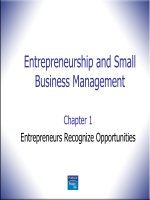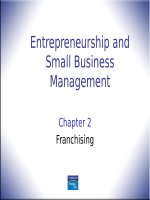Entrepreneurship and small business management chapter 13
Bạn đang xem bản rút gọn của tài liệu. Xem và tải ngay bản đầy đủ của tài liệu tại đây (390.21 KB, 28 trang )
Entrepreneurship and
Small Business
Management
Chapter 13
Using Financial Statements to
Guide a Business
Ch. 13 Performance
Objectives
Understand an income statement.
Examine a balance sheet to
determine a business’s financing
strategy.
Use the balance sheet equation for
analysis.
Perform a financial ratio analysis of
an income statement.
Entrepreneurship and Small Business
Management, 1/e
2
© 2012 Pearson Education, Upper Saddle River, NJ
07458.
Ch. 13 Performance
Objectives
(continued)
Calculate return on investment.
Perform same-size (common-size) analysis of an income statement.
Use quick, current, and debt ratios to analyze a balance sheet.
Entrepreneurship and Small Business
Management, 1/e
3
© 2012 Pearson Education, Upper Saddle River, NJ
07458.
Financial Statements
Entrepreneurs use three basic financial statements:
Income statement
Balance sheet
Cash flow statement
Together, these financial reports show the health of a business at a glance.
Entrepreneurship and Small Business
Management, 1/e
4
© 2012 Pearson Education, Upper Saddle River, NJ
07458.
Income Statement
Shows profit or loss over a particular time period
Revenues > Expenses = Positive Balance
Expenses > Revenues = Negative Balance
Prepared monthly
Serves as a scorecard; helps reveal problems
Entrepreneurship and Small Business
Management, 1/e
5
© 2012 Pearson Education, Upper Saddle River, NJ
07458.
Parts of an Income
Statement
Revenue
COGS/COSS
Gross profit
Other variable
costs
Contribution
margin
Fixed operating
costs
Entrepreneurship and Small Business
Management, 1/e
6
Earnings before
interest and
taxes
Pre-tax profit
Taxes
Net profit/(loss)
© 2012 Pearson Education, Upper Saddle River, NJ
07458.
Income Statement: Basic
Format
Entrepreneurship and Small Business
Management, 1/e
7
© 2012 Pearson Education, Upper Saddle River, NJ
07458.
Income Statement
Calculations
Entrepreneurship and Small Business
Management, 1/e
8
© 2012 Pearson Education, Upper Saddle River, NJ
07458.
A Simple Income
Statement
Entrepreneurship and Small Business
Management, 1/e
9
© 2012 Pearson Education, Upper Saddle River, NJ
07458.
An Income Statement for a More
Complex Business
Entrepreneurship and Small Business
Management, 1/e
10
© 2012 Pearson Education, Upper Saddle River, NJ
07458.
Balance Sheet
Called a “point-in-time” financial statement because it shows the state of a business at a given moment
Typically prepared quarterly and at the end of the fiscal year (12-month accounting period chosen by the firm)
Entrepreneurship and Small Business
Management, 1/e
11
© 2012 Pearson Education, Upper Saddle River, NJ
07458.
Parts of a Balance Sheet
Assets—things the company owns that are worth money
Liabilities—the company’s debts that must be paid (including unpaid bills)
Owner’s Equity (OE)—
Assets – Liabilities = OE
Also called “net worth”
The amount of capital in the company
Entrepreneurship and Small Business
Management, 1/e
12
© 2012 Pearson Education, Upper Saddle River, NJ
07458.
Balance Sheet (Horizontal
Format)
Entrepreneurship and Small Business
Management, 1/e
13
© 2012 Pearson Education, Upper Saddle River, NJ
07458.
Types/Examples of Assets
Current assets—cash, items easily
turned into cash, and items used within
one year
Accounts receivable
Inventory
Supplies
Long-term assets—items that would
take the business more than one year
to use
Equipment
Furniture
Machinery
Real estate
Entrepreneurship and Small Business
Management, 1/e
14
© 2012 Pearson Education, Upper Saddle River, NJ
07458.
Types/Examples of
Liabilities
Current liabilities—debts scheduled for
payment within one year (includes
portion of long-term debt due within
the year)
Long-term liabilities—debts to be paid
over a time period longer than one year
Examples of liabilities:
Accounts payable (bills)
Loans from banks, family, or friends
Mortgages
Lines of credit
Entrepreneurship and Small Business
Management, 1/e
15
© 2012 Pearson Education, Upper Saddle River, NJ
07458.
The Balance Sheet Equation
Assets – Liabilities = Owner’s Equity (OE)
or
Assets = Liabilities + Owner’s Equity
or
Liabilities = Assets – Owner’s Equity
(Net worth and capital are other names
for OE.)
Entrepreneurship and Small Business
Management, 1/e
16
© 2012 Pearson Education, Upper Saddle River, NJ
07458.
Total Assets Must Equal
(“Balance”) Total Liabilities +
Owner’s
Equity
If an item was
financed with debt, the loan is a
liability.
If an item was purchased with the owner’s (or
shareholders’) money, it was financed with equity.
Liabilities and owner’s equity pay for all assets.
Entrepreneurship and Small Business
Management, 1/e
17
© 2012 Pearson Education, Upper Saddle River, NJ
07458.
Analyzing Balance Sheet
Data
Compare balance sheets from two different points in time to see progress.
Calculate the percentage of change between the reports for each line item.
An increase in owner’s equity is one way to measure success.
Entrepreneurship and Small Business
Management, 1/e
18
© 2012 Pearson Education, Upper Saddle River, NJ
07458.
Income Statement Ratios
Express each line item as a percentage of
sales to see the relationship between items.
Amount
(M)
Calculation
% of
Sales
Sales
$10
($10 ÷ $10) x
100
100%
Less total COGS
$4
($4 ÷ $10) X
100
40%
Less other var.
costs
$0
Contribution
margin
$6
($6 ÷ $10) X
100
60%
Less fixed op.
costs
Entrepreneurship and Small Business
$3
($3 ÷ $10) x
30%
100
© 2012 Pearson Education, Upper Saddle River, NJ
Management, 1/e
$ 3 19
($3 ÷ $10) x
Profit
30%
07458.
Return on Investment (ROI)
Entrepreneurs “invest” time, energy, and money because they expect a “return” of money or satisfaction.
Return on investment (ROI)
measures return as a percentage
of the original investment.
(Net Profit ÷ Investment) X 100 =
ROI%
Entrepreneurship and Small Business
Management, 1/e
20
© 2012 Pearson Education, Upper Saddle River, NJ
07458.
Things Needed to Calculate
ROI
Net profit—amount the firm has earned
beyond what it has spent to cover costs
Total investment—start-up investment
plus any additional money invested
later
Period of time for which you are
calculating ROI—typically one month or
one year
Entrepreneurship and Small Business
Management, 1/e
21
© 2012 Pearson Education, Upper Saddle River, NJ
07458.
Return on Sales (ROS)
ROS is also called the “profit margin” because it is an important measure of business profitability.
Net income ÷ sales = ROS
To express this ratio as a percentage, multiply it by 100.
Entrepreneurship and Small Business
Management, 1/e
22
© 2012 Pearson Education, Upper Saddle River, NJ
07458.
Volume and Price Impact
ROS
ROS
Margin
Range
Very low
Low
2-5%
6-10%
Typical Product
Very high volume OR very high
price
High volume OR high price
Moderate
11-20%
Moderate volume AND moderate
price
High
20-30%
Low volume OR low price
Very high
30% and up
Entrepreneurship and Small Business
Management, 1/e
Very low volume OR very low
price
23
© 2012 Pearson Education, Upper Saddle River, NJ
07458.
Common-Sized (“Same-Size”)
Analysis
Lets you compare income statements,
even if sales amounts vary.
Compare your expenses with those
incurred by other businesses in your
industry, or for your own company at
different points in time.
Operating ratio—expresses what
percentage of sales dollars a particular
expense item is using up
Entrepreneurship and Small Business
Management, 1/e
24
© 2012 Pearson Education, Upper Saddle River, NJ
07458.
Quick and Current Ratios
Quick Ratio:
(Cash + Marketable Securities) ÷ Current Liabilities
Marketable securities—investments such as
certificates of deposit or Treasury bills
If the quick ratio is greater than one, there is
enough cash to cover all bills (but not loans) within
24 hours.
Current Ratio:
Current Assets ÷ Current Liabilities
If the current ratio is greater than one, the
business could sell some assets to pay off its
debts.
Entrepreneurship and Small Business
Management, 1/e
25
© 2012 Pearson Education, Upper Saddle River, NJ
07458.









